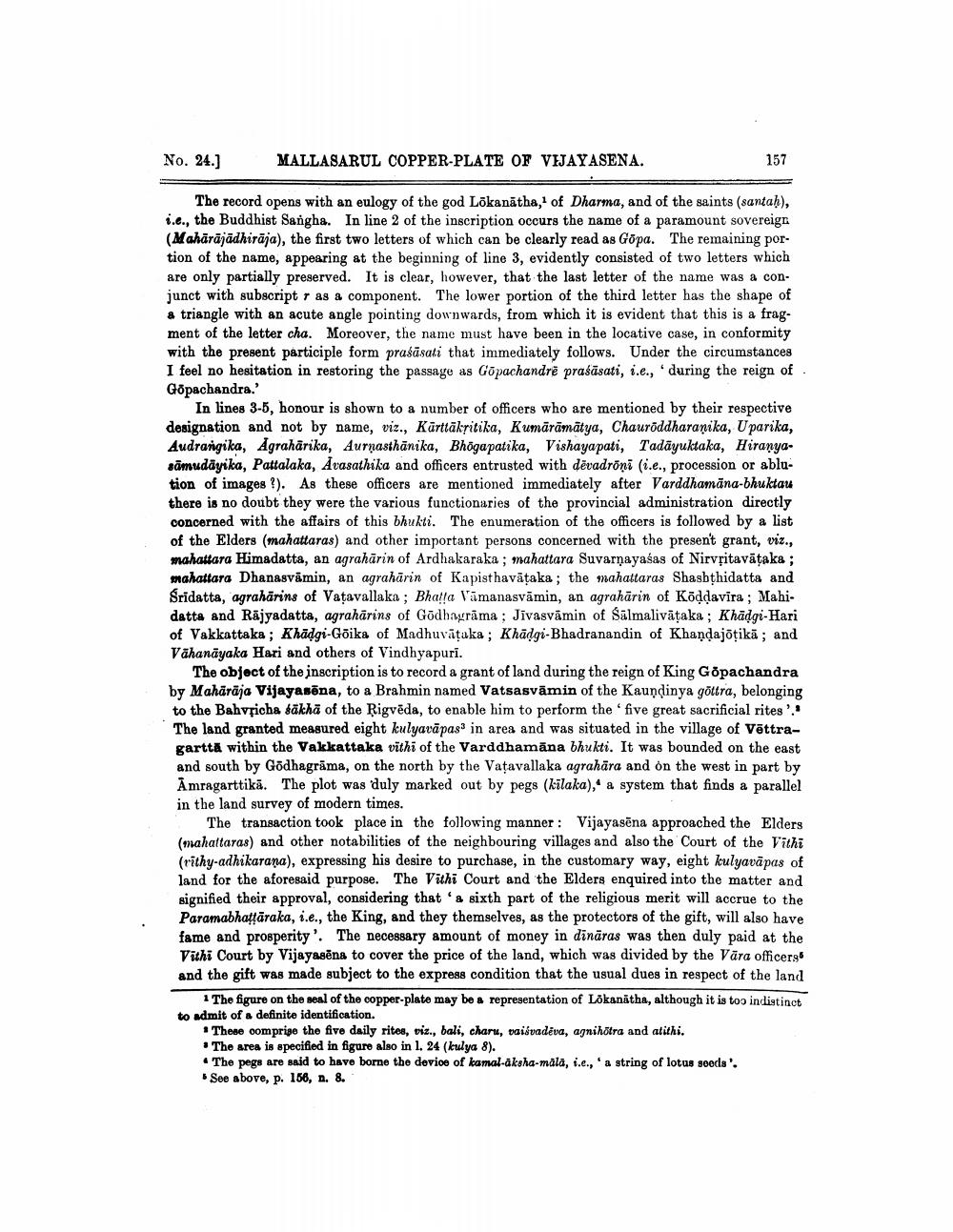________________
No. 24.)
MALLASARUL COPPER-PLATE OF VIJAYASENA.
157
The record opens with an eulogy of the god Lõkanātha, of Dharma, and of the saints (santah), i.e., the Buddhist Sangha. In line 2 of the inscription occurs the name of a paramount sovereign (Mahārājādhirāja), the first two letters of which can be clearly read as Göpa. The remaining portion of the name, appearing at the beginning of line 3, evidently consisted of two letters which are only partially preserved. It is clear, however, that the last letter of the name was a conjunct with subscript as a component. The lower portion of the third letter has the shape of a triangle with an acute angle pointing downwards, from which it is evident that this is a fragment of the letter cha. Moreover, the name must have been in the locative case, in conformity with the present participle form prasāsati that immediately follows. Under the circumstances I feel no hesitation in restoring the passage as Gopachandrē praśāsati, i.e., during the reign of . Gopachandra.'
In lines 3-5, honour is shown to a number of officers who are mentioned by their respective designation and not by name, viz., Kārttākritika, Kumārāmātya, Chaurõddharanika, Uparika, Audrangika, Agrahārika, Aurnasthānika, Bhöga patika, Vishayapati, Tadāyuktaka, Hiranyasāmudayika, Pattalaka, Avasathika and officers entrusted with dēvadrõni (i.e., procession or ablution of images ?). As these officers are mentioned immediately after Varddhamāna-bhuktau there is no doubt they were the various functionaries of the provincial administration directly concerned with the affairs of this bhukti. The enumeration of the officers is followed by a list of the Elders (mahattaras) and other important persons concerned with the present grant, viz., mahattara Himadatta, an agrahārin of Ardhakaraka; mahattara Suvarnayasas of Nirvșitavāțaka ; mahattara Dhanasvamin, an agrahārin of Kapisthavāțaka; the mahattaras Shasbthidatta and Sridatta, agrahārins of Vatavallaka; Bhatta Vāmanasvāmin, an agrahārin of Koddavira; Mahidatta and Rājyadatta, agrahārins of Godhagrāma; Jīvasvāmin of Sālmalivātaka ; Khadgi-Hari of Vakkattaka; Khādgi-Gõika of Madhuvātaka; Khādgi-Bhadranandin of Khandajõţikā; and Vāhanayaka Hari and others of Vindhyapuri.
The object of the inscription is to record a grant of land during the reign of King Gopachandra by Mahārāja Vijayasēna, to a Brahmin named Vatsasvāmin of the Kaundinya göttra, belonging to the Bahvřicha sākhā of the Rigvēda, to enable him to perform the five great sacrificial rites'. The land granted measured eight kulyavāpas: in area and was situated in the village of Vēttragartta within the Vakkattaka vithi of the Varddhamāna bhukti. It was bounded on the east and south by Gödhagrāma, on the north by the Vațavallaka agrahāra and on the west in part by Āmragarttikā. The plot was duly marked out by pegs (kilaka), a system that finds a parallel in the land survey of modern times.
The transaction took place in the following manner : Vijayasēna approached the Elders (mahattaras) and other notabilities of the neighbouring villages and also the Court of the Vithi (rithy-adhikarana), expressing his desire to purchase, in the customary way, eight kulyavāpas of land for the aforesaid purpose. The Vithi Court and the Elders enquired into the matter and signified their approval, considering that's sixth part of the religious merit will accrue to the Paramabhattāraka, i.e., the King, and they themselves, as the protectors of the gift, will also have fame and prosperity'. The necessary amount of money in dināras was then duly paid at the Vithi Court by Vijayasēna to cover the price of the land, which was divided by the Vāra officergs and the gift was made subject to the express condition that the usual dues in respect of the land
1 The figure on the seal of the copper-plate may be a representation of Lokanatha, although it is too indistinct to admit of a definite identification.
These comprise the five daily rites, viz., bali, charu, vaišvadēva, agnihotra and atithi. • The area is specified in figure also in l. 24 (kulya 8). • The pegs are said to have borne the devioe of kamal-aksha-mala, i.e., ' a string of lotus soods'. See above, p. 156, R. 8.




